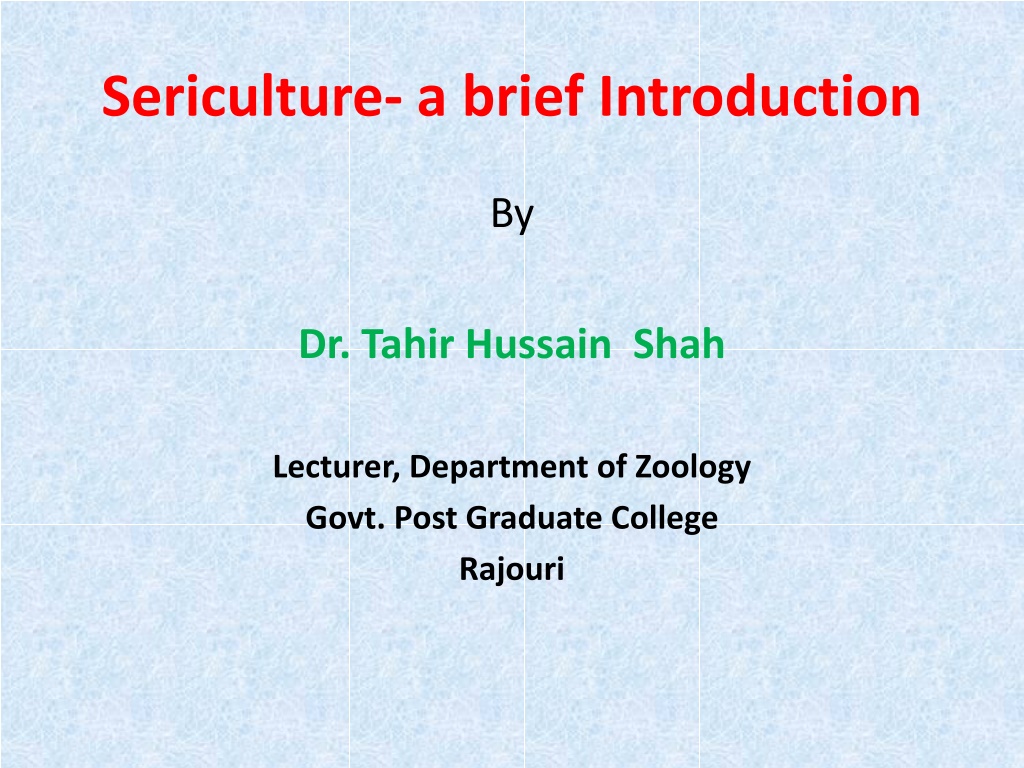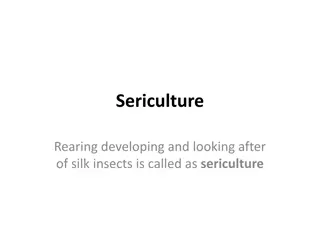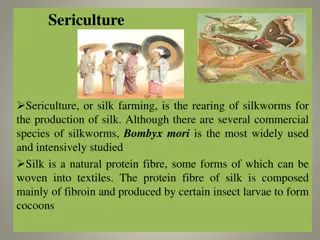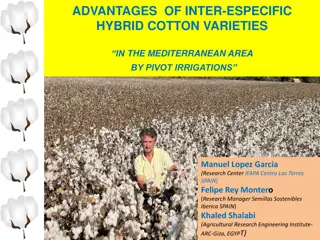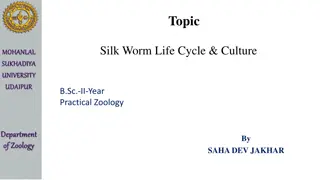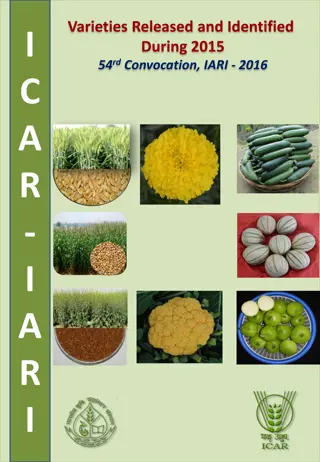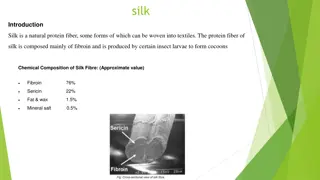Overview of Sericulture: Silk Production and Varieties
Sericulture, also known as silk farming, involves rearing silkworms to produce silk. The most common species is Bombyx mori, which produces a natural protein fiber known as silk. Different types of silkworms feed on various plants, with mulberry silk being the most commercially significant. India produces diverse silk varieties, including mulberry, tasar, and oak tasar. Silk is valued for its versatility, comfort, moisture absorption, and dyeability, making it a popular choice for textiles.
Download Presentation

Please find below an Image/Link to download the presentation.
The content on the website is provided AS IS for your information and personal use only. It may not be sold, licensed, or shared on other websites without obtaining consent from the author. Download presentation by click this link. If you encounter any issues during the download, it is possible that the publisher has removed the file from their server.
E N D
Presentation Transcript
Sericulture- a brief Introduction By Dr. Tahir Hussain Shah Lecturer, Department of Zoology Govt. Post Graduate College Rajouri
Sericulture Sericulture, or silk farming, is the rearing of silkworms for the production of silk. There are several commercial species of silkworms, Bombyx mori is the most widely used and intensively studied Silk is a natural protein fibre, some forms of which can be woven into textiles. The protein fibre of silk is composed mainly of fibroin and produced by certain insect larvae to form cocoons
Why Sericulture It is versatile and very comfortable. It absorbs moisture. It is cool to wear in the summer yet warm to wear in winter. It can be easily dyed. It retains its shape and is relatively smooth. It has a poor resistance to sunlight exposure. It is the strongest natural fiber and is lustrous
Type of silkworm There are five major types of silk of commercial importance, different species of silkworms which in turn feed on a number of food plants Except mulberry, other varieties of silks are generally termed as non-mulberry silks. India has the unique distinction of producing all these commercial varieties of silk obtained from
Mulberry The bulk of the commercial silk produced in the world comes from this variety and often silk generally refers to mulberry silk Mulberry silk comes from the silkworm, Bombyx mori L. which solely feeds on the leaves of mulberry plant( Mulberry sp. Morus alba, M. indica) In India, the major mulberry silk producing states are Karnataka, Andhra Pradesh, West Bengal, Tamil Nadu and Jammu & Kashmir which together accounts for 92 % of country's total mulberry raw silk production
Tasar Tasar (Tussah) is copper in colour, coarse silk mainly used for furnishings and interiors. Tasar silk is generated Antheraea mylitta, which mainly thrive on the food plants Asan and tomentosa, T. arjuna) In India, Tasar silk is mainly produced in the states of Jharkhand, Chhattisgarh and Orissa, besides Maharashtra, West Bengal and Andhra Pradesh. by the silkworm, Arjun (Terminalia
Oak Tasar It is a finer variety of tasar generated by the silkworm, Antheraea proyeli J. in India which feed on natural food plants of oak, (Quercus serrata, Q. incana) found in abundance in the sub-Himalayan belt of India covering the states of Manipur, Himachal Pradesh, Assam, Meghalaya and Jammu & Kashmir Uttar Pradesh, China is the major producer of oak tasar in the world and this comes from another silkworm which is known as Antheraea pernyi
Eri Also known as Endi or Errandi, Eri is a multivoltine silk spun from open-ended cocoons, unlike other varieties of silk Eri silk is the product of the domesticated silkworm, Philosamia ricini , Attacus ricini that feeds mainly on castor leaves ( Ricinus communis) The silk is used indigenously for preparation of chaddars (wraps) for own use by these tribals. In India, this culture is practiced mainly in the north-eastern states and Assam. It is also found in Bihar, West Bengal and Orissa
Muga This golden yellow colour silk is prerogative of India and the pride of Assam state. It is obtained from semi-domesticated multivoltine silkworm, Antheraea assamensis These silkworms feed on the aromatic leaves of Som ( Machilus sp.) and Soalu ( Litsea sp.) plants Muga culture is specific to the state of Assam and an integral part of the tradition and culture of that state. The muga silk, an high value product is used in products like sarees, mekhalas, chaddars, etc.
